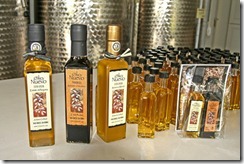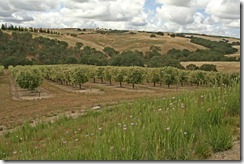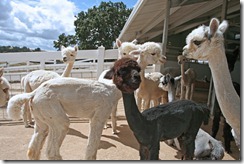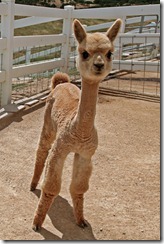 It wasn’t enough for Art Kishiyama to just grow olive trees and make olive oil, he had to raise Alpacas too. This retired Air Force Colonel, who also had a post-military career with Disney, settled in the eastern area of Paso Robles with his artist wife, Lynne and became a gentleman farmer.
It wasn’t enough for Art Kishiyama to just grow olive trees and make olive oil, he had to raise Alpacas too. This retired Air Force Colonel, who also had a post-military career with Disney, settled in the eastern area of Paso Robles with his artist wife, Lynne and became a gentleman farmer. Kishiyama’s 3,700 olive trees span out across a sloping terrain adjacent to a large pond that sits behind the house where Lynne has her art studio. It is a lovely, serene setting.
The olive oil, under the label Olio Nuevo, is sold at specialty stores, markets, and wineries throughout the county. Each bottle is delicately hand crafted at his small production center. The oil is Extra Virgin and is certified by the California Olive Oil Council.
Two distinctive types of oil are produced, Olio Nuevo Estate Arbequina and Olio Nuevo Reserve Blend. Kishiyama uses predominantly green, early harvested Arbequina fruit for the first as he feels it presents a fresh, grassy taste. This oil is a good complement to fish, poultry, cooked vegetables, and meats.
The Reserve Blend contrasts the Estate Arbequina in that it is harvested late using much riper Arbequina fruit. Estate grown Manzinillo and Mission fruit are blended in and all three produce a fine, smooth, less bitter tasting oil.
Kishiyama also offers Balsamic of Modena, an aged balsamic made specifically to pair with the olive oils. This balsamic is imported from Modena, Italy.
But olives aren’t all that is growing at the Kishiyama’s place. Art also raises Alpacas. That part of the property is known as the Alpacas of Cripple Creek.
Nearby are the holding pens and barn for the Alpacas. These easy to raise animals have grown in popularity in recent years and most are bred for their coats that yield exceptional fiber.
But alpacas have another quality that makes them special, they sing or rather they hum. Spanish conquistadors referred to them as “humming sheep.” They also make other kinds of sounds like a high pitched whining along with noisy inhalations. These help to warn both the herd and other domestic farm animals of danger. This makes sales of the animals for guard duties popular.
Alpacas are originally from the Andes in South America, primarily from Peru, Bolivia, and Chile. Their nearest relatives are vicuna and they share territory with them as well as llamas and guanacos, all of which are camelids. Alpacas are no longer wild and have been domesticated for more than 5000 years.
Kishiyama raises and breeds for specific colors whereas many people p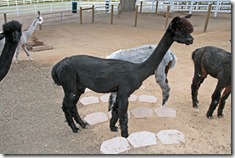 refer white animals in order to dye the fleece. In the United States it is becoming more popular to obtain fiber from a natural colored animal. Kishiyama’s alpacas come in fawn, beige, gray, white, brown, black, and black-brown. There are 22 natural colors of alpacas but Kishiyama prefers the blacks and grays.
refer white animals in order to dye the fleece. In the United States it is becoming more popular to obtain fiber from a natural colored animal. Kishiyama’s alpacas come in fawn, beige, gray, white, brown, black, and black-brown. There are 22 natural colors of alpacas but Kishiyama prefers the blacks and grays.
 refer white animals in order to dye the fleece. In the United States it is becoming more popular to obtain fiber from a natural colored animal. Kishiyama’s alpacas come in fawn, beige, gray, white, brown, black, and black-brown. There are 22 natural colors of alpacas but Kishiyama prefers the blacks and grays.
refer white animals in order to dye the fleece. In the United States it is becoming more popular to obtain fiber from a natural colored animal. Kishiyama’s alpacas come in fawn, beige, gray, white, brown, black, and black-brown. There are 22 natural colors of alpacas but Kishiyama prefers the blacks and grays. Because alpacas are herd animals Kishiyama never sells only one to a customer and although he maintains a small male herd, he prefers to select males from other breeders based on the amount of curl in their coat. A bit of curl in the coat aids in spinning the yarn.
There is no specific time for females to come into heat. Ovulation only occurs after mating and usually a pregnancy will occur with one mating, but to be sure, Kishiyama continues a mating pair until a pregnancy is confirmed. Females give birth in 11 months and usually produce one offspring called a cria.
Many people worry about behavior issues, such as the notion that alpacas and llamas will spit. While they can bring up some nasty greenish stomach contents that they will project at times, this is usually aimed at other members of their herd.
The nice thing about these animals are their bathroom behaviors. They tend to use a communal dung pile in a specific location rather than spreading it around randomly. This helps to keep enclosures neat and tidy and makes clean-up an easier chore.
Alpacas don’t necessarily enjoy physical contact. They will tolerate some petting on their bodies, but do not like their abdomen, lower legs and feet being touched.
All in all alpacas are relatively easy to raise, enjoyable to watch, and produce an excellent fiber that can be spun and made into a yarn for producing soft, silky garments. Since it is not prickly and contains no lanolin, it is good for people with allergies.
Art keeps busy with olive oil production and tending to the alpacas, while Lynne works away in her spacious studio producing beautiful and delicate paintings, collages, and abstracts done with hand-made papers and an oriental flair. These two have got it made with olives, alpacas, and fine art.
